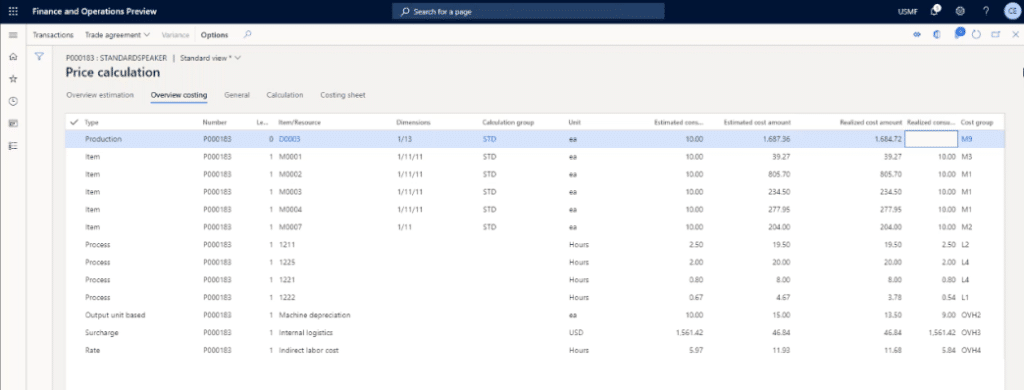On the Job with Dynamics 365 for Manufacturing Production Managers
Manufacturing production managers are responsible for a wide variety of tasks - from understanding the shop floor to managing incoming and current projects and jobs, to analyzing production data and reports – production managers have a lot to juggle – but that can all be handled within Dynamics 365.
Workspaces in Dynamics 365
Workspaces in Dynamics 365 help manufacturing production managers create and maintain resources, set up calendars, and more. A variety of workspaces come out of the box within the system and allow production managers to get up and running quickly with a system view that includes one-click access to the most important areas in the system for their specific job function.
Resource Groups in Dynamics 365
Resource groups are a set of operations resources that typically correspond to the physical organization of work cells, defined by yellow lines on the production shop floor. These groups are important to set up, establish, and adjust when changes or updates are made. Within Dynamics 365, production managers have complete control over all items in resource groups and have the ability to update when needed.
Within the Resource lifecycle management view, you can see a variety of calendars that help manage production cycles, working times, payroll, and more. By accessing the different calendars, you can gain a better understanding of how much you need to produce and what your capacity is.
For example, the working times calendar is a guide to each day’s schedule, holidays, expected downtimes, closures, and more. By updating the working times within the system, information flows into capacity planning and automatically updates projections and plans based on the amount of time the manufacturing floor will be in production.
Watch Working Times in Action
The resources themselves are the key to setting capabilities and capacities. In Dynamics 365, resources can be machines, vendors, human resources, tools, or facilities. Once each resource is set up, the system automatically calculates output and capacity planning based on details for available resources.
Asset Work Order Management in Dynamics 365
One area that is frequently overlooked in the system is the asset work order management workspace. In this area, you can
- Monitor the status of your machines
- Watch for unexpected downtime
- Review preventative maintenance schedules
- View maintenance requests
- View work orders created from those maintenance requests and find status information
- View all assets on the production floor
- Schedule maintenance events for machines based on set parameters. For example, after a certain number of hours in use, following a certain number of items produced, a specific time period, etc.
- View machines down and expected time to restart
- Predict downtimes
Watch Asset Work Order Management in Action
Production Floor Management in Dynamics 365
An additional workspace available is production floor management. Within this area, you can see all production orders, different journal types, time and attendance details, job information – including terminals and devices. Within the job information, production managers can access real-time information on jobs in progress, jobs scheduled, products being produced, quantities, resources, operators, and more. Gantt Charts can be automatically generated from this workspace that includes information on specific jobs, time scales, capacity load, material due dates, and more.
Watch Production Production Floor Management in Action
Quality Control in Dynamics 365
In Dynamics 365 you can create production orders, which can include quality orders for review to understand the product’s quality history and testing results. Quality orders can be created for products that are noncompliant or you can put in these orders as a whole, which requires them to be held and tested prior to being moved to inventory.
While there isn’t a quality control workspace out of the box, you can create your own workspace and add in the areas of quality management functionality within the system.
Production Costing in Dynamics 365
Manufacturing production managers can access information related to labor, time, materials, and more in order to easily calculate the cost of production.
When an order is marked in the system as ‘reported as finished’, manufacturing production managers have the ability to view a breakdown of all items cost into the order and realized costs vs estimated costs.
Watch Production Costing in Action
With Dynamics 365, manufacturing production managers have the information they need at their fingertips. Learn more about how Dynamics 365 can benefit your manufacturing operation. Continue reading more on our blog or reach out to our manufacturing experts.
Under the terms of this license, you are authorized to share and redistribute the content across various mediums, subject to adherence to the specified conditions: you must provide proper attribution to Stoneridge as the original creator in a manner that does not imply their endorsement of your use, the material is to be utilized solely for non-commercial purposes, and alterations, modifications, or derivative works based on the original material are strictly prohibited.
Responsibility rests with the licensee to ensure that their use of the material does not violate any other rights.











